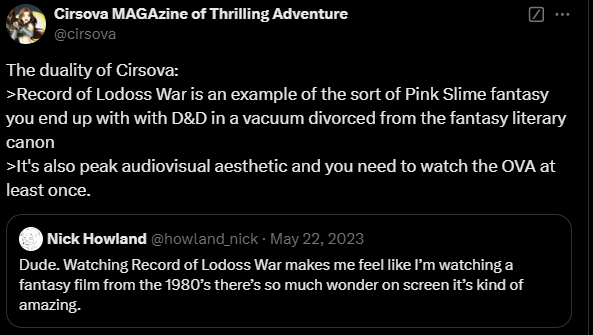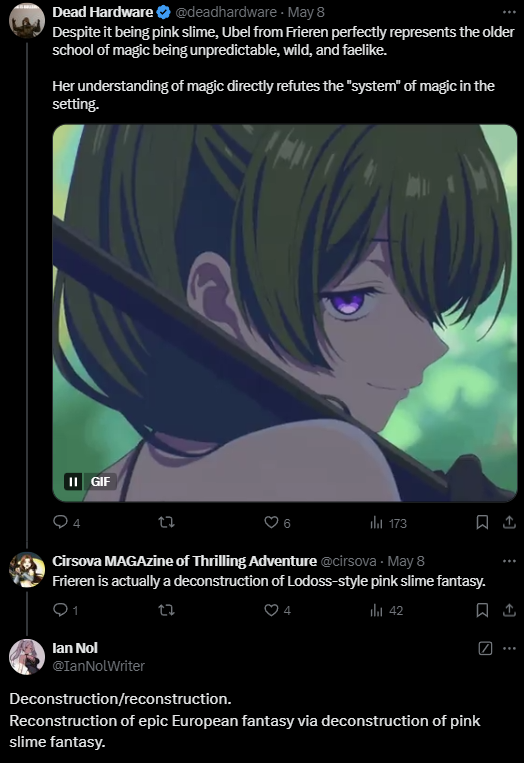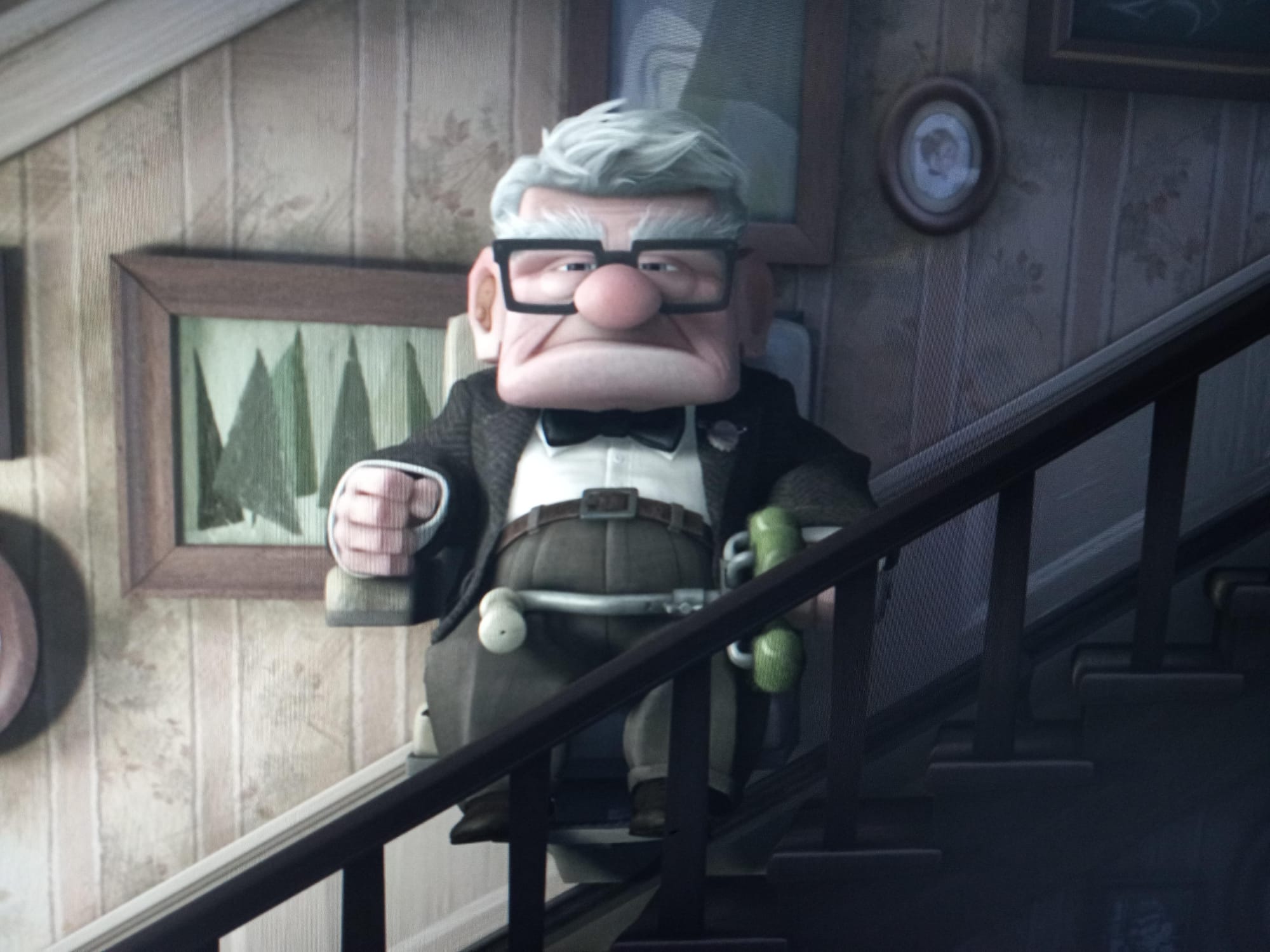Frieren and Dungeon Meshi: Beyond Romance's End

The society emerging at the conclusion of comedy represents, by contrast, a kind of moral norm, or pragmatically free society. Its ideals are seldom defined or formulated: definition and formulation belong to the humors, who want predictable activity. We are simply given to understand that the newly-married couple will live happily ever after, or that at any rate they will get along in a relatively unhumorous and clear-sighted manner. That is one reason why the character of the successful hero is so often left undeveloped: his real life begins at the end of the play, and we have to believe him to be potentially a more interesting character than he appears to be.
–Northrop Frye, The Anatomy of Criticism, Third Essay
A technique that I have been developing is to read two thematically-connected works in sequence so that I can investigate their structural principles by comparing and contrasting the two works.
In this case, I recently watched the anime adaptions of Frieren: Beyond Journey's End and Dungeon Meshi [or Delicious in Dungeon]. Both started as manga and then were quickly adapted for animation. There is an obvious connection between the two series as they are both Japanese takes on D&D, but what I am interested in is how each story is an attempt to move beyond contemporary genre conventions to tell their stories in a fresh way. I believe that the outsized success of each series is due to the success of this artistic vision.
There is a lot to unpack there, so let's start by defining what I mean by contemporary genre conventions. Fantasy in particular has become a very narrow genre, with a limited set of conventional forms that are derisively known as "pink slime". One of the greatest examples of pink slime fantasy animes is the Record of the Lodoss War.

A pink slime fantasy is a kind of generic medieval setting with magic and a few instantly recognizable demihuman races, such as elves, orcs and dwarves. If you read fantasy stories written before 1980, you will be struck by their incredible diversity, by the depth and breadth of imagination such stories represent. After that point, everything tends to look and feel more and more similar.

It is easy to point the finger at D&D's outsized cultural footprint here, but I think there is a case to be made that the beginnings of the generic pseudo-medieval setting with the serial numbers filed off can be seen as early as William Morris' The Well at World's End, which is honestly less weird and otherworldly than the medieval Christendom that inspired it.

But setting is only part of what is going on here. What Frye called "mode of heroic action" and "thematic mode" have also become very limited in this kind of a story. Again, while it would be easy to blame the overuse of Joseph Campbell's Hero's Journey, I think there are structural roots that go further back.

Most fantasy stories are adventures, romances or a sequence of marvelous adventures in the older terminology, and the dominant form of the adventure story in the twentieth and early twenty-first centuries is a romance told in a relatively realistic way, once you account for whatever differences there are between the fantasy setting and the world in which we live. These stories are also usually comedies in Frye's sense: a story in which the hero becomes integrated into his society.

The standard way in which a comedic romance ends is that the hero is victorious, the bad guy gets dead, and the hero marries the princess. Some of the complaints about this kind of story structure are that it often leaves the character of the hero relatively undeveloped, and that everything after the wedding, which comprises the majority of the characters' lives, is summed up as "happily ever after".
As literature has developed over the course of the twentieth century, this has felt more and more like a gap that needs to be filled, even though Frye rightly points out in the quote I used to open this essay that there are deep mythic reasons for this plot structure. Symbolically, the story is of the hero returning to happy normality after successfully completing his quest. However, this has become so remote and unattainable for many readers that we yearn for something more concrete in our stories.
The final piece we need to set up my analysis is that we need to understand the specifically Japanese context here. There are two parts to this. First, the Record of Lodoss War has been very influential in setting the genre conventions of Japanese fantasy, but it did so in a way that was divorced from the English literary roots of D&D. The Appendix N books that inspired D&D were largely un-translated and unknown in Japan in the 1980s, and so Japanese D&D games of the era went off the visual aesthetic of the game materials.

The second piece is that starting in the mid-00s, Japanese popular art developed two distinct but related problems, the overuse of moe and slice-of-life stories. Moe is hard to define, but it is a strange combination of childishness and sex appeal that ends up going very bad places in the pursuit of ever smaller but ever more obsessed groups of consumers. Slice-of-life stories are simply low-stakes portrayals of real life, not bad in and of themselves, but in combination with moe slice-of-life crowded out most other kinds of story for ten or fifteen years.
Things have changed in Japanese art over the last decade, and I think both Frieren and Dungeon Meshi continue that trend. Each one represents a different way of telling a fantasy story in a way that bypasses conventions that have begun to feel stale, but the way in which this has been done is that the art has become more deeply conventional, connecting with the archetypes and mythic roots of the genre.
The possession of originality cannot make an artist unconventional; it drives him further into convention, obeying the law of the art itself, which seeks constantly to reshape itself from its own depths, and which works through its geniuses for metamorphosis, as it works through minor talents for mutation.
–Northrop Frye, The Anatomy of Criticism, Third Essay
Frieren has two interesting aspects. First, it represents a re-engagement with the Western fantasy canon. And second it is an attempt to directly address the "happily ever after" problem of comedic romance by telling a story that happens after the bad guy is dead and the quest has been completed. The subtitle of the series emphasizes this, "Beyond Journey's End".
The primary way in which Frieren re-engages the Western fantasy canon is by making demihumans something other than humans in a fancy costume. Contemporary play in D&D has this problem too, having also lost its connection to the wildness and weirdness of the fae. Take elves, for example. All the elves we meet in the story are weird.

The few elves we meet in the course of the story have interests and motivations that are entirely different from the far more numerous but shorter-lived humans. Frieren is a special case, being relatively closer to humans, but even in her case it takes decades for things to sink in with her.
I've been showing my kids the Frieren anime, and wife complained that it was slow, and nothing happened. This is true! Everything is paced super slow, and this is because we are sharing the point of view of Frieren, for whom the passage of ten years means almost nothing. It would be very difficult for elves and humans to see anything the same way when their lifespans are so different.
In line with this, the story is very ambitious in its use of time, ranging over decades in the main story and hundreds or thousands of years in flashbacks. I appreciate the way the passage of years and seasons is handled, harkening back to the kriegspiel roots of D&D, which sought to manage logistics, transportation, and weather as obstacles that could be even more formidable than opposing armies.
Frieren also plays with the "happily ever after" aspect of the conventional romance. In this case the kingdom as a whole experiences a period of prolonged peace and prosperity following the defeat of the Demon King, but there was a missed opportunity for the other kind of romance and happily ever after that Frieren was too elvish [autistic] to notice, and the primary dramatic tension in the story comes from her slow realization of that fact.

Much like Spy x Family, Frieren seems to be a case of good art that is also pro-family propaganda. But since Frieren is so ambitious with how it presents time, it has sufficient range to also thematically embrace how we prepare to die. Adventure in particular often has something of a blind spot when it comes to the challenges of aging, being a genre that is often focused on the exploits of the young. By adopting Frieren's point of view, we are able to see ourselves from the outside, to see the grand sweep of a single life in the blink of an eye. And in doing so, Frieren also manages to grant a measure of dignity to the aged.

Earlier, I noted that one of the challenges with the traditional form of the romance is that anagogically, the ending of a comedic romance maps onto an ideal form of human life. This ideal has become remote for us, and so while I understand what Frye was saying about it, I am also sympathetic with the many people who were left wanting more.
Frieren is an answer to "what would more look like?" in the literary form of the romance. In the specifically Japanese context, Frieren is telling a story that has lower stakes than its most famous precedent, which was apocalyptic in scope, and it does so by pushing that part of the story into the background and focusing on relatively mundane events.
In this way, Frieren pulls on the popularity of slice-of-life and cozy fantasy, but real danger still lurks in the world. Frieren also stands out for its relatively modest character design, which is something that tended to extremes of fan service in the moe-dominant decades.
When we pass into anagogy, nature becomes, not the container, but the thing contained, and the archetypal universal symbols, the city, the garden, the quest, the marriage, are no longer the desirable forms that man constructs inside nature, but are themselves the forms of nature. Nature is now inside the mind of an infinite man who builds his cities out of the Milky Way.
–Northrop Frye, The Anatomy of Criticism, Second Essay

Despite the similarity in the source material, Dungeon Meshi goes in a completely different direction than Frieren. Initially, Dungeon Meshi feels like a slice-of-life style story that is leaning all the way in on the "what if dungeons had an ecology" conceit of post-2000 D&D. And then it abruptly veers into tragedy.
The particular thing called tragedy that happens to the tragic hero does not depend on his moral status. If it is causally related to something he has done, as it generally is, the tragedy is in the inevitability of the consequences of the act, not in its moral significance as an act. Hence the paradox that in tragedy pity and fear are raised and cast out. Aristotle's hamartia or "flaw," therefore, is not necessarily wrongdoing, much less moral weakness: it may be simply a matter of being a strong character in an exposed position, like Cordelia. The exposed position is usually the place of leadership, in which a character is exceptional and isolated at the same time, giving us that curious blend of the inevitable and the incongruous which is peculiar to tragedy.
–Northrop Frye, The Anatomy of Criticism, First Essay
If we return to Frye's fundamental comic-tragic axis, a comedy is when a character is being integrated into society, and a tragedy is when a character is being expelled from society. Laios and Marcille's increasingly desperate actions to resurrect Laios' sister cross so many lines that it is hard to see how they could ever be allowed back into polite society, but their motivations in doing so retain the audience's sympathy.

Dungeon Meshi succeeds in this because it plays it absolutely straight, without any kind of ironic distance or self-parody. Laios and party get into trouble because of their respective obsessions, but those same obsessions are understandable and even endearing. The tragedy is not about Laios and Marcille being villains, but about the inevitable consequences of those obsessions in this context.

I am in favor of more well-written tragedies in adventure stories, because in my opinion this form is currently underutilized. And this is a well-written tragedy. But at the same time, Dungeon Meshi also plays into its conceits about eating all the monsters in the dungeon and also focuses strongly on its main characters to provide slightly lessened stakes.

In the background, you can see factional conflict, grand politics, and intra-party rivalries, but the foreground is mostly more mundane things, which works out well in this case. The struggles of Laios and party are more personal, more relatable, because of this narrative focus.
Dungeon Meshi is more middle of the road when it comes to character design and fanservice, but again after the extremes of the moe-era, it feels pretty tame in this regard.
Thus we can see that each series ends up moving beyond generic pink slime fantasy, but in distinct ways. Frieren tries to provide a satisfying answer to what happens when the quest is over. It still has stakes, but it moves them down a notch from apocalyptic. Dungeon Meshi is a tragic adventure instead of a comic one, but it maintains sympathy for its characters.
These two series stand out because they do not follow the established conventions slavishly, and they are better for it. The way out is through, not by being less conventional, but by being more conventional, finding the deeper reasons why stories are told in a certain way, and then reshaping the art based upon that.
Buy Frieren manga on Amazon
Buy Frieren anime on Amazon
Buy Dungeon Meshi manga on Amazon



Comments ()